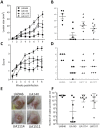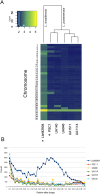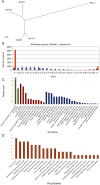Genomic Analysis of Colombian Leishmania panamensis strains with different level of virulence
- PMID: 30478412
- PMCID: PMC6255768
- DOI: 10.1038/s41598-018-35778-6
Genomic Analysis of Colombian Leishmania panamensis strains with different level of virulence
Abstract
The establishment of Leishmania infection in mammalian hosts and the subsequent manifestation of clinical symptoms require internalization into macrophages, immune evasion and parasite survival and replication. Although many of the genes involved in these processes have been described, the genetic and genomic variability associated to differences in virulence is largely unknown. Here we present the genomic variation of four Leishmania (Viannia) panamensis strains exhibiting different levels of virulence in BALB/c mice and its application to predict novel genes related to virulence. De novo DNA sequencing and assembly of the most virulent strain allowed comparative genomics analysis with sequenced L. (Viannia) panamensis and L. (Viannia) braziliensis strains, and showed important variations at intra and interspecific levels. Moreover, the mutation detection and a CNV search revealed both base and structural genomic variation within the species. Interestingly, we found differences in the copy number and protein diversity of some genes previously related to virulence. Several machine-learning approaches were applied to combine previous knowledge with features derived from genomic variation and predict a curated set of 66 novel genes related to virulence. These genes can be prioritized for validation experiments and could potentially become promising drug and immune targets for the development of novel prophylactic and therapeutic interventions.
Conflict of interest statement
The authors declare no competing interests.
Figures





Similar articles
-
Evaluation of a Multilocus Sequence Typing (MLST) scheme for Leishmania (Viannia) braziliensis and Leishmania (Viannia) panamensis in Colombia.Parasit Vectors. 2017 May 12;10(1):236. doi: 10.1186/s13071-017-2175-8. Parasit Vectors. 2017. PMID: 28499458 Free PMC article.
-
Mucosal leishmaniasis: A forgotten disease, description and identification of species in 50 Colombian cases.Biomedica. 2019 Aug 1;39(Supl. 2):58-65. doi: 10.7705/biomedica.v39i3.4347. Biomedica. 2019. PMID: 31529834 English, Spanish.
-
Intraspecific heterogeneity in the mini-exon gene localization of Leishmania (Viannia) panamensis and Leishmania (Viannia) guyanensis from Colombia.J Parasitol. 2000 Dec;86(6):1250-3. doi: 10.1645/0022-3395(2000)086[1250:IHITME]2.0.CO;2. J Parasitol. 2000. PMID: 11191900
-
Evidence for hybridization by multilocus enzyme electrophoresis and random amplified polymorphic DNA between Leishmania braziliensis and Leishmania panamensis/guyanensis in Ecuador.J Eukaryot Microbiol. 1997 Sep-Oct;44(5):408-11. doi: 10.1111/j.1550-7408.1997.tb05716.x. J Eukaryot Microbiol. 1997. PMID: 9304809
-
Leishmania Viannia guyanensis.Trends Parasitol. 2019 Dec;35(12):1018-1019. doi: 10.1016/j.pt.2019.06.008. Epub 2019 Jul 8. Trends Parasitol. 2019. PMID: 31292065 Review. No abstract available.
Cited by
-
Variation in Leishmania chemokine suppression driven by diversification of the GP63 virulence factor.PLoS Negl Trop Dis. 2021 Oct 28;15(10):e0009224. doi: 10.1371/journal.pntd.0009224. eCollection 2021 Oct. PLoS Negl Trop Dis. 2021. PMID: 34710089 Free PMC article.
-
In-depth quantitative proteomics uncovers specie-specific metabolic programs in Leishmania (Viannia) species.PLoS Negl Trop Dis. 2020 Aug 17;14(8):e0008509. doi: 10.1371/journal.pntd.0008509. eCollection 2020 Aug. PLoS Negl Trop Dis. 2020. PMID: 32804927 Free PMC article.
-
Gene Annotation and Transcriptome Delineation on a De Novo Genome Assembly for the Reference Leishmania major Friedlin Strain.Genes (Basel). 2021 Aug 29;12(9):1359. doi: 10.3390/genes12091359. Genes (Basel). 2021. PMID: 34573340 Free PMC article.
-
Application of next generation sequencing (NGS) for descriptive analysis of 30 genomes of Leishmania infantum isolates in Middle-North Brazil.Sci Rep. 2020 Jul 23;10(1):12321. doi: 10.1038/s41598-020-68953-9. Sci Rep. 2020. PMID: 32704096 Free PMC article.
-
Genetic diversity and comparative genomics across Leishmania (Viannia) species.Commun Biol. 2025 Jun 14;8(1):925. doi: 10.1038/s42003-025-08331-1. Commun Biol. 2025. PMID: 40517149 Free PMC article.
References
-
- World Health, O. Control of the leishmaniases. World Heal. Organ Tech Rep Ser xii–xiii, 1–186, back cover (2010). - PubMed
Publication types
MeSH terms
LinkOut - more resources
Full Text Sources

